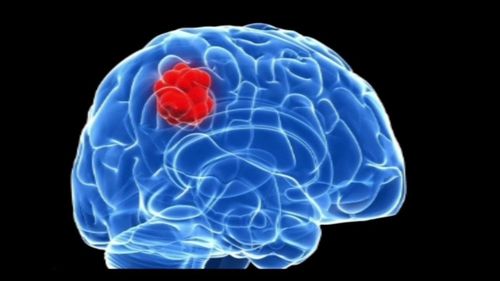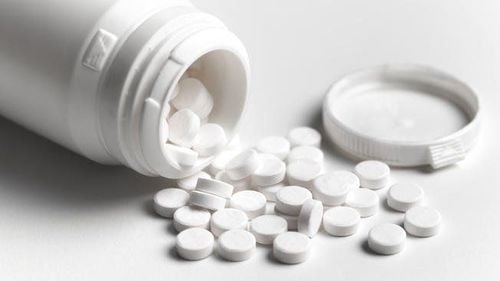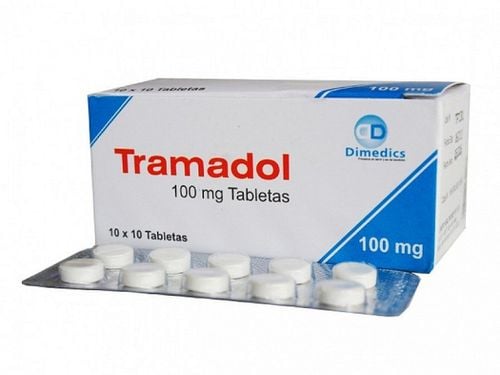This is an automatically translated article.
Tramadol belongs to the group of central opioid analgesics. The drug is available in the form of tablets or capsules. When using the drug can cause unwanted side effects such as visual disturbances, vomiting, abdominal pain... Therefore, patients should learn carefully and consult a treating doctor.
1. Mechanism of action of the drug Tramadol
Tramadol belongs to the group of synthetic analgesics that have a central analgesic effect and can cause addiction to drugs such as morphine. Tramadol analgesics and metabolites such as O-desmethyl tramadol - M1 of tramadol can bind to M-receptors of neurons and reduce the re-entry of norepinephrine and serotonin into cells that have an analgesic effect. pain. Metabolite M1 has a 200-fold higher affinity for the m-receptor and six-fold greater analgesic effects than Tramadol.
The analgesic effect may appear after taking the drug within 1 hour and reach its maximum after 2 to 3 hours. Unlike morphine, Tramadol does not cause histamine-releasing reactions and has no effect on heart rate and left ventricular function. The therapeutic dose of Tramadol is less respiratory depression than morphine.
Tramadol is well absorbed from the gastrointestinal tract, but the first-pass metabolism through the liver is stronger, so the absolute bioavailability of Tramadol is only about 75%. The time to reach maximum drug concentrations in the blood will vary between Tramadol and its metabolites, estimated to be about 2 hours after administration, and about 3 hours for M1 metabolites. Food has little effect on the absorption of the drug and when the drug enters the body, it can bind to protein about 20% and distribute in all organs in the body with a volume of distribution accounting for 2.7 liters/kg body weight. important.
In the body, Tramadol is also metabolized through N and O demethylation reactions with the catalysis of 2 isoenzymes CYP3A4 and CYP2D6 - which convert the drug into O - desmethyl tramadol with analgesic effect. Therefore, when used with Tramadol, compounds that cause allergies to isoenzymes will change the effect of Tramadol. Furthermore, CYP2D6 enzyme activity is also genetic.
Tramadol is eliminated mainly by the kidneys, accounting for 90% and the remaining 10% will be eliminated in the feces. The drug Tramadol in the body will be in the untransformed form accounting for 30% and the metabolized form will account for 10%. The elimination half-life of Tramadol has a duration of 6.3 hours while that of the M1 metabolite is about 7.4 hours longer.
The pharmacokinetics of Tramadol vary little with age. In subjects over 75 years of age, the elimination half-life is slightly increased. Or in patients with renal impairment, the clearance of Tramadol decreases in parallel with the clearance of creatinine.
2. Indications and contraindications for the use of Tramadol
Tramadol is indicated for the treatment of severe or moderate pain. Or cases of pain when there are contraindications or using other pain relievers without effective treatment. However, Tramadol is also contraindicated in some cases with a history of hypersensitivity to the drug or opioid components. People who are using MAO inhibitors or are new to drugs are also not recommended to use this drug. Or cases of severe liver failure, or severe respiratory failure, children under 15 years old, ... contraindicated to use Tramadol.
3. Dosage and how to use Tramadol
Tramadol has a dosage depending on the response of each patient as well as the acute or chronic condition.
For acute pain, the patient can use oral or rectal medicine. With Tramadol 50mg - 100mg can be used slowly intravenously over 2 to 3 minutes and administered at intervals of 4 to 6 hours. When using the slow release tablets can be taken 1 to 2 times a day, and the total dose should not exceed 400mg. Also rectal can be used 100mg each time and the maximum dose is used 4 times / day. For post-operative analgesia, an initial dose of 100 mg should be used, followed by a further dose of 50 mg after 10 to 20 minutes, the maximum total dose in the first hour may be 250 mg and after 4 to 6 hours 50 to 100 mg. . The maximum total dose should not exceed 600mg.
For chronic pain, it is recommended to use long-term drugs and do not need drugs with fast pain relief. Because with these subjects, patients need to be investigated for treatment to assess the level of response and appropriateness of the drug. The initial dose should be at 25 mg/day and then increased by a dose of 25 mg/day to 4 times/day after 3 days to achieve a dose of 100 mg/day. In case the drug is still not satisfactory, after 3 days, it should be increased by 50 mg daily until a total dose of 200 mg/day or higher is reached. Dosage is suitable for patients to increase the dose from 50 to 100 mg / time with each use 4 to 6 hours apart, to achieve a total dose not to exceed 400 mg / day. In case of underlying disease with impaired liver or kidney function, it is necessary to reduce the dose and prolong the time between two doses. For example, in patients with impaired renal function with creatinine clearance less than 30ml/min, the interval between two doses should be 12 hours and the total dose should not exceed 200mg/day. In case of severe renal impairment with creatinine clearance less than 10ml/min, Tramadol should not be used. In case the patient accidentally overdoses on Tramadol than prescribed and has some signs such as shortness of breath, fainting, convulsions, etc., it is necessary to take the patient to an emergency at the nearest medical facility. to be able to provide timely support to help patients overcome dangerous situations. Tramadol overdose cases can cause death with doses from 3 to 5 grams. In women weighing 40 kg can be fatal with the lowest dose of 0.5 to 1 gram. Treatment of overdose situations can depend on the level of dose taken into the body, there will be different methods. But first, it is necessary to maintain good ventilation and actively treat the patient. At the same time, anticonvulsant with sleeping pills. In addition, in case of Tramadol poisoning, activated charcoal can be used to increase absorption and decrease absorption of Tramadol into the body.
If the patient using Tramadol has missed a dose, the missed dose can be used as soon as he remembers. However, if there is a gap between the missed dose and the next dose, the patient may skip the missed dose and take the next dose. Patients should also be careful not to use double the dose because it can cause drug overdose and unwanted side effects affecting the patient's condition.
Besides, Tramadol drug can cause unwanted side effects at different levels with each patient's case such as nausea, headache, dizziness, decreased mental concentration, dry mouth, sweating. smell..
Above is all important information about Tramadol, before using you should read the information carefully and consult your doctor for the best indications.
Please dial HOTLINE for more information or register for an appointment HERE. Download MyVinmec app to make appointments faster and to manage your bookings easily.













